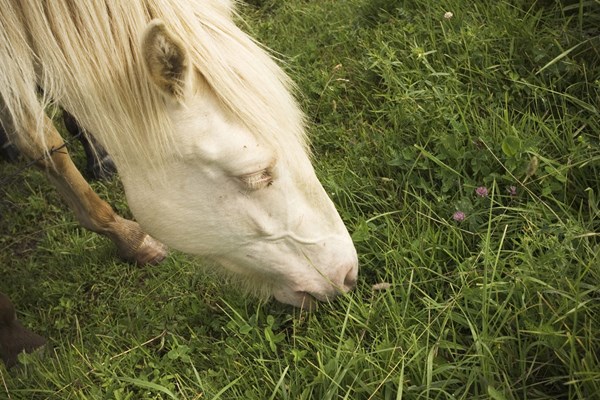 Credit: Thinkstock Pasture turnout can trigger a bout of laminitis even in lean, non-obese horses with no history of laminitis.
Credit: Thinkstock Pasture turnout can trigger a bout of laminitis even in lean, non-obese horses with no history of laminitis.Scores of horses will gorge themselves on that long-awaited lush, green pasture of springtime. As many of us already know, overgrazing grasses and legumes that are high in water-soluble carbohydrates puts horses at risk for laminitis—a painful, life-threatening condition of the hooves.
“Many horse owners are already aware that pasture-associated laminitis is particularly concerning for overweight horses and ponies, easy keepers, those with insulin resistance or equine metabolic syndrome, and horses and ponies with a history of chronic laminitis. It is important for owners to appreciate, however, that pasture turnout can trigger a bout of laminitis even in lean, non-obese horses with no history of laminitis,” said Bryan Waldridge, DVM, MS, DACVIM, head veterinarian at Kentucky Equine Research.
There are several steps owners can take to avoid pasture-associated laminitis in the spring:
1. Make all dietary changes slowly. If your horse has been on a specific type of hay or other forage over the past few months, do not suddenly turn it out on pasture for the bulk of every day.
2. Avoid grazing for all horses at-risk of laminitis. Use grazing muzzles or turn out horses on drylots. This will also help maintain an appropriate body weight (body condition score), which helps protect against development of laminitis and some diet-related disorders.
3. Be strategic in choosing turnout times. When turning out laminitis-prone horses to graze, turn them out in the early morning and evening because that is when the water-soluble carbohydrate levels are lowest. That said, note that those are peak mosquito feeding periods, so owners may wish to use insect repellants and fly sheets to help avoid mosquito-borne illness.
4. Recall that at-risk horses need to be monitored daily for signs of laminitis. Even if maintained on pasture with low or moderate levels of water-soluble carbohydrates, some horses are still prone to future bouts of laminitis. Early indications include hooves that are warm to the touch, and horses that appear sore or unwilling to move.
5. Explore turnout options. If pasture turnout is nonnegotiable at your facility, considering pasture analysis and consultation with a certified equine nutritionist. Your local extension specialist may also have some valuable information regarding appropriate pasture management, such as mowing, rotation schedules, and different type of grasses to plant.
“It is also important to appreciate that lack of grazing is not synonymous with lack of turnout. Horses, especially those with a history of laminitis, benefit from turnout and regular exercise to increase circulation to the feet and maintain an appropriate body weight. Horses also benefit from the social interaction and routine hoof care,” advised Waldridge.
Visit equinews.com/newsletters to subscribe to The Weekly Feed, KER’s award-winning equine nutrition newsletter.For horses or ponies that are at risk for or have a history of laminitis, KER nutritionists recommend daily use of EquiShure, a hindgut buffer that can maintain the normal hindgut environment.


